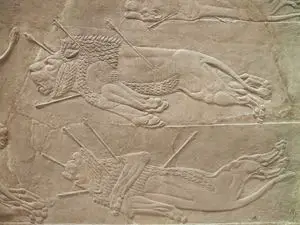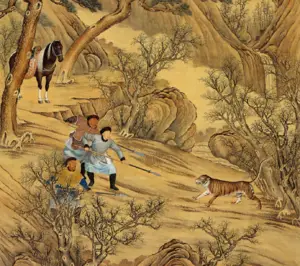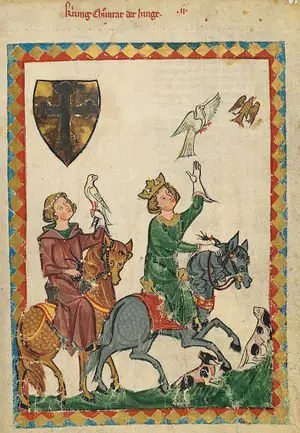How did hunting become a symbol of the aristocracy/royalty
For centuries, hunting became associated with kingship, where large tracts of land were preserved for the kings' pleasure as they would hunt a variety of game and even exotic animals imported from abroad. While on the surface this was merely an excess that kings exercised and may have had little to do with running the affairs of the state, from the earliest development of kingship, and until much later periods, hunting was seen as critical for displaying royal authority. Far more than pleasure or sport, hunting had an important social function in establishing not only the kings' power but demonstrating the vitality of the state.
Early Developments
Perhaps the first evidence of hunting being associated with a type of royal power or a leader of some type comes from ancient Mesopotamia, particularly the city of Uruk. A stele was found that showed a type of leader displaying his power and engaged in hunting a lion from the late 4th millennium BC at around 3400 BCE.[1] What is significant about this find is we know that hunting and taming lions was a way to display royal power and ability to control nature, an important symbolic representation in later periods. The fact we see such symbolic references to power in a period when cities were just developing show that the symbols of power were developing early as kingdoms first arose.
The royal hunt continued to be important and in later periods, by the 1st millennium BCE during the Assyrian Empire between the 9th-7th centuries BCE, hunting took on a new level of importance. Royal parks were now built that contained exotic plants and exotic game, including lions, for the king to hunt. Animals were released in arenas and, at least symbolically, kings were shown killing lions (Figure 1). Taming wild animals, particularly powerful animals such as lions, depicted or represented the kingdom being in good hands and a successful hunt can show the favor the gods had over the kingdom. In fact, the official royal seal of the Assyrian Empire showed the king stabbing a lion with his sword. In effect, the ultimate symbol of earthly power as it subdues the most powerful animal of the wild. Taming the wild forces that could threaten the kingdom and state were important symbols represented through the royal hunt.[2]
Hunting in ancient Greece was an activity conducted commonly, as it was seen as a right of passage for men. After contacts with the ancient Near East world, the royal hunt became popular among Greek rulers in the Hellenistic Age.[3] Hunting by royal households and emperors was also popular in the Roman world. Hadrian was known, for example, to hunt wild bears in Greece and other locations. The Roman emperors began to hunt a variety of wild game as they encountered new animals with their empire expanding.[4]
Despite the fact that much of ancient Indian society was vegetarian, kings did participate in hunting.[5] In fact, sometimes the names of kings often referred to these activities as a way to remember these kings in later periods. Kings hunted deer and lion and even when there was condemnation of this activity it still seemed common to kings.
In ancient China, the hunt was also important for royalty. Royal parks were created such as in the Han Dynasty (206 BCE–220 CE), where dogs would be reared and used during these royal activities.[6] It was important for the Chinese emperors to find and kill their prey, thus parks are important as a means to ensure there were animals present. Deer, tigers, and rhinoceroses were among the animals hunted in the royal parks (Figure 2). We know that in some periods the royal hunt was also used as an occasion to invite foreign emissaries and diplomats. The emperor would use the opportunity to conduct court business and would use the occasion as an official gathering rather than in the main capital.
In both China and Assyria, the origin of the royal parks and gardens, rather than being a focus of only exotic plants, can be argued to be just as important as places for releasing wild game so that kings and emperors could engage in royal hunts. In other words, the activity of hunting gave primacy to many of these parks in their roles for kingship and power.[7]
Medieval Hunting
The Medieval kings of Europe adopted Roman and ancient traditional practices of kingship, which included hunting. Although hunting was done by all classes, it was a critical sign of nobility to be involved in the royal hunts. Areas were often reserved solely for the king and his nobles, particularly in England and Gascony, for kings to hunt and kings would conduct much of their business during the hunt.[8] The strength and reputation of kings often depended on their success in royal hunts.
Royal hunts involved kings and their entourage on horseback but also using hounds and hawks or falcons. In fact, hawking and falconry, another royal activity, was often associated as an activity with hunting (Figure 3). The use of hawks and falcons was generally reserved for noble families and royal households. Hunting included the "at force" hunting, where wild boar would be chased by groups of men before trapping and killing the animal. The bow hunt was reserved for deer, which was considered a more docile activity. The large male deer was often seen as the chief of animals in Europe and, therefore, was much prized in the royal hunt. As with the ancient royal hunt, in the Medieval period the royal hunt was a sign of the king's effective rule of the state. However, hunting was also symbolic, where the slaying of the deer was seen as similar to Christ's suffering and sacrifice.[9]
Modern Day Royalty and Hunting
Among the various royal activities that have changed over the millennia of royalty, hunting still persists as a key activity in royal households around the world. In the 19th century, exotic hunting became a popular activity for heads of state and royalty, including expeditions to India or Africa, where once again hunting lions became a key symbol for royal power. Many pictures of royalty hunting dangerous wild game became important and during the 19th and early 20th century, when powers began to compete once again for global dominance, particularly German and the United Kingdom, hunting became a symbol of projecting power to adversaries and the home audience alike. Kaiser Wilhelm II, in particular, enjoyed being portrayed as a strong hunter and often boasted of his many successful hunts. Similar to earlier rulers, important decisions were often made during hunts, where ministers would be gathered and decisions about arming and building the navy were made during royal hunts as the world headed to World War I.[10]
Royal families, even as it has become fashionable to advocate for animal rights, continue to be active hunters, although exotic game are now seen as potentially out of bounds. In many ways, hunting is now largely seen as a leisure activity more than as a symbol of royal power. Unlike the past, news of hunts are more subdued and some controversy exists in continuing the tradition of royal hunting.
Conclusion
The royal hunt was an important symbol of power for kings and emperors. Few activities, such as the royal hunt, persist since the inception of royalty in the late 4th millennium BCE. The origin of parks and large reserves, rather than starting as areas to protect animals and plants, were initially intended to be reserves for royalty to commence in the hunt. The hunt was also a time to conduct important state business and meet dignitaries, perhaps similar to how golf is done today by US presidents and other world leaders. The royal hunt, at times a dangerous activity, as kings could be vulnerable to injury or even death, was also seen as an arena to demonstrate that the king was in control and powerful, an important symbol for the state and its continuity.
Related DailyHistory.org Articles
References
- ↑ For more discussion on the early development of the royal hunt, see: Aruz, J., Exhibition Art of the First Cities: The Third Millenium B.C. from the Mediterranean to the Indus, & Metropolitan Museum of Art (Eds.). (2003). Art of the first cities: the third millennium B. C. from the Mediterranean to the Indus ; [published in conjunction with the Exhibition Art of the First Cities: the Third Millennium B. C. from the Mediterranean to the Indus, held at the Metropolitan Museum of Art, New York, from May 8 to August 17, 2003] (2. print). New Haven: Yale Univ. Press, pg. 23.
- ↑ For more on the royal hunt in the Neo-Assyrian period, see: Ataç, M.-A. (2010). The mythology of kingship in Neo-Assyrian art. Cambridge ; New York: Cambridge University Press, pg. 132.
- ↑ For more on hunting during the Hellenistic Age, see: Strootman, R. (2014). Courts and elites in the Hellenistic empires: the Near East after the Achaemenids, c. 330 to 30 BCE. Edinburgh: Edinburgh University Press, pg. 199.
- ↑ For more on Roman Emperors hunting, see: Canepa, M. P. (2009). The two eyes of the Earth: art and ritual of kingship between Rome and Sasanian Iran. Berkeley, Calif: University of California Press, pg. 159.
- ↑ For more on ancient royal hunting in India, see: Sen, S. N. (1999). Ancient Indian history and civilization. New Delhi: New Age International, pg. 134.
- ↑ For more information on the royal hunt in ancient China, see: Duindam, J. F. J., & Dabringhaus, S. (Eds.). (2014). The dynastic centre and the provinces: agents and interactions. Leiden ; Boston: Brill, pg. 141.
- ↑ For more on ancient royal parks, see: Allsen, T. T. (2006). The royal hunt in Eurasian history. Philadelphia: University of Pennsylvania Press.
- ↑ For more on the royal hunts and hunting grounds in the Medieval period, see: Jeanrenaud, S. (2001). Communities and forest management in Western Europe: a regional profile of WG-CIFM the Working Group on Community Involvement in Forest Management. Gland: IUCN, pg. 16.
- ↑ For more on the importance of hunting, symbolism, and other activities, see: Allsen 2011
- ↑ For more on modern hunting by royal families, see: Vinen, R. (2002). A history in fragments: Europe in the twentieth century. London: Abacus. and Allsen 2011: 176.


